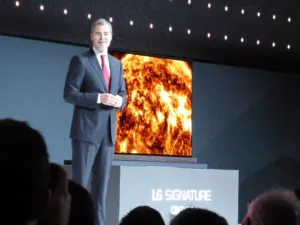In terms of products, there will be four OLED TV series launched this year – however, the lower-end models may not reach all markets.
The most premium set is the G6, in 55″, 65″ and 77″ sizes. It is a very thin TV because the electronics are in the stand, rather than the TV. The E6, in 55″ and 65″ sizes, is identical to the G6 in all ways, but the electronics are in the TV.
The other TVs are the curved C6 and flat B6. These will be simple updates to the 2015 models, with new panels and a new main board for HDR processing.
All of the new OLED sets are UltraHD Premium certified by the UHD Alliance. The LCD sets are not, due to the combination of high (1,000 cd/m²) brightness and dark black requirements. LG found that making the LCD sets follow the UHD-A’s specification made them as expensive to produce as OLED TVs.
The G6 TV, as was mentioned in the press conference, covers 99% of the DCI-P3 colour gamut. This was achieved with a mix of new phosphors, which have also extended the panel’s lifetime. Previously, driving an OLED at 1,000 cd/m² would have significantly shortened panel lifetime. Vignetting (the loss of brightness at the edge of the OLED display) has also been solved with use of a new probe in the manufacturing process.
We have heard that the 65″ E6 TV has already appeared on Amazon, for $7,000.
LG’s LCD TVs this year will be known as ‘Super UHD’, and will include the UH9800 (98″), UH9500 (55″ – 86″), UH8500 (55″ – 75″) and UH7700 (49″ – 65″). They will begin to be shipped in the spring.
All of the TVs feature IPS panels with technologies such as True Black Panel (lowers reflections and enhances contrast ratio) and Contrast Maximiser. They are also HDR-enabled, with an SDR-to-HDR conversion feature and LG’s Color Prime technology. The UH9500 and UH8500 also use LG’s Color Prime Plus; this is an expanded colour gamut using a new, thicker colour filter and new phosphors. The Color Prime Plus models cover 90% of DCI-P3.
LG’s UH9800 is solely available in a 98″ size, and features 8k resolution. It will come to market this year, although there is no indication of price. It is unlikely that LG will mass-produce this TV, instead manufacturing it only when a customer orders one.
Last of all were LG’s new smartphones, the K series: the K10 and K7. These are aimed at younger users. They feature a 2.5D glass design and 13MP (front) and 8MP (rear) cameras. LG’s Gesture Shot and Gesture Selfie features are included.
The K10 has a 5.3″ in-cell display with 1280 x 720 resolution. It runs Android 5.1 on a 1.3GHz quad-core (3G/4G) or 1.14GHz octa-core (4G) processor. RAM is 1GB, 1.5GB or 2GB and storage is 8GB or 16GB. The battery is 2,300mAh.
LG’s K7 has a 5″ display with 854 x 480 resolution, and either in-cell (4G) or on-cell (3G) touch. The 4G unit uses a 1.1GHz quad-core proessor, while the 3G uses a 1.3GHz quad-core device. RAM is the same as the K10, excluding the 2GB option.
The new PH550, PW1000 and PW1500 projectors (Glass, Projection and UHD at CES) were being shown. These are all RGB LED (30,000-hour lifetime) models, with 1280 x 720 resolution, in LG’s Minibeam series. Displays can be shared wirelessly from Android and Windows devices to the projectors, using WiDi. The PW models feature a digital TV tuner.
The PH550 has 500 lumens of brightness, the PW1000 has 1,000 lumens and the PW1500 has 1,500 lumens. The projectors will be on sale soon, but a price was only available for the PH550 ($600).

